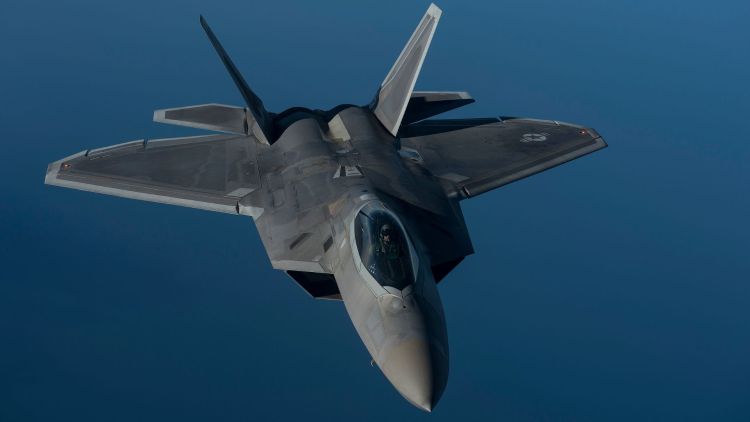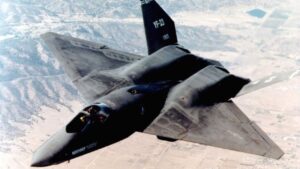The following piece first appeared on Warrior Maven, a Military Content Group member website.
Decades after the F-22 Raptor first took to the sky, the stealth fighter is still regarded by many as the best air supremacy jet the world has ever seen in large measure because the Air Force and Lockheed have continued a decades-long modernization, upgrade, and sustainment campaign intended to ensure the platform remains relevant and dominant.
While the F-22 was without question paradigm-changing at the time of its arrival, today’s Raptor is an almost entirely different airplane due to continued modernization efforts to improve the plane’s stealth coating, electronics, weapons systems, sensing, and targeting technologies.
In just the last few years, the Air Force and Lockheed have added sensing, electronics, datalinks, software, and improved radar to the F-22 Raptor. Developers have also equipped the stealth fighter with more long-range precision attack technology, a wider targeting envelope or “field of regard,” and new networking technology enabling improved, real-time “collaborative targeting” between aircraft.
F-22
Two new or upgraded weapons, which have been operational on F-22s for several years now, are advanced variants of existing weapons – the AIM-9X air-to-air missile and the AIM 120-D. Upgraded variants of each are now operational. The new AIM-9X will shoot farther and reach a much larger targeting envelope for pilots. Working with a variety of helmets and display systems, Lockheed developers have added “off-boresight” targeting ability, enabling pilots to attack enemies from a wide range of new angles.
Raytheon AIM-9X weapons developers have told Warrior that the Block 2 variant adds a redesigned fuse and a digital ignition safety device that enhances ground handling and in-flight safety. Block II also features updated electronics that enable significant enhancements, including lock-on-after-launch capability using a new weapon datalink to support beyond visual range engagements, a Raytheon statement said.
Another part of the weapons upgrade includes engineering the F-22 to fire the AIM-120D, a beyond visual range Advanced Medium-Range Air-to-Air Missile (AMRAAM), designed for all weather day-and-night attacks; it is a “fire and forget” missile with active transmit radar guidance, Raytheon data states. The AIM-120D is built with upgrades to previous AMRAAM missiles by increasing attack range, GPS navigation, inertial measurement units and a two-way data link, Raytheon statements explain. As the Air Force and Lockheed Martin move forward with weapons envelope expansions and enhancements for the F-22, there is of course a commensurate need to upgrade software and its on-board sensors to adjust to emerging future threats, industry developers explained.
Ultimately, this effort will lead the Air Force to draft up requirements for new F-22 sensors.F-22 lethality is also getting vastly improved through integration of new two-way LINK 16 data link connectivity between aircraft, something which will help expedite real-time airborne “collaborative targeting.”
The following piece first appeared on Warrior Maven, a Military Content Group member website.
Decades after the F-22 Raptor first took to the sky, the stealth fighter is still regarded by many as the best air supremacy jet the world has ever seen in large measure because the Air Force and Lockheed have continued a decades-long modernization, upgrade, and sustainment campaign intended to ensure the platform remains relevant and dominant.
While the F-22 was without question paradigm-changing at the time of its arrival, today’s Raptor is an almost entirely different airplane due to continued modernization efforts to improve the plane’s stealth coating, electronics, weapons systems, sensing, and targeting technologies.
In just the last few years, the Air Force and Lockheed have added sensing, electronics, datalinks, software, and improved radar to the F-22 Raptor. Developers have also equipped the stealth fighter with more long-range precision attack technology, a wider targeting envelope or “field of regard,” and new networking technology enabling improved, real-time “collaborative targeting” between aircraft.
F-22
Two new or upgraded weapons, which have been operational on F-22s for several years now, are advanced variants of existing weapons – the AIM-9X air-to-air missile and the AIM 120-D. Upgraded variants of each are now operational. The new AIM-9X will shoot farther and reach a much larger targeting envelope for pilots. Working with a variety of helmets and display systems, Lockheed developers have added “off-boresight” targeting ability, enabling pilots to attack enemies from a wide range of new angles.
Raytheon AIM-9X weapons developers have told Warrior that the Block 2 variant adds a redesigned fuse and a digital ignition safety device that enhances ground handling and in-flight safety. Block II also features updated electronics that enable significant enhancements, including lock-on-after-launch capability using a new weapon datalink to support beyond visual range engagements, a Raytheon statement said.
Another part of the weapons upgrade includes engineering the F-22 to fire the AIM-120D, a beyond visual range Advanced Medium-Range Air-to-Air Missile (AMRAAM), designed for all weather day-and-night attacks; it is a “fire and forget” missile with active transmit radar guidance, Raytheon data states. The AIM-120D is built with upgrades to previous AMRAAM missiles by increasing attack range, GPS navigation, inertial measurement units and a two-way data link, Raytheon statements explain. As the Air Force and Lockheed Martin move forward with weapons envelope expansions and enhancements for the F-22, there is of course a commensurate need to upgrade software and its on-board sensors to adjust to emerging future threats, industry developers explained.
Ultimately, this effort will lead the Air Force to draft up requirements for new F-22 sensors.F-22 lethality is also getting vastly improved through integration of new two-way LINK 16 data link connectivity between aircraft, something which will help expedite real-time airborne “collaborative targeting.”
Having a digital ability to transmit fast-changing, combat relevant targeting information from an F-22 cockpit – without needing voice radios – lessens the risk associated with more “jammable” or “hackable” communications.
Newer F-22s have a technology called Synthetic Aperture Radar, or SAR, which uses electromagnetic signals or “pings” to deliver a picture or rendering of the terrain below, allowing better target identification. The SAR technology sends a ping to the ground and then analyzes the return signal to calculate the contours, distance and characteristics of the ground below. The F-22 is also known for its “super cruise” technology which enables the fighter to reach speeds of Mach 1.5 without needing to turn on its afterburners. This enables the fighter to travel faster and farther on less fuel, a scenario which expands its time for combat missions.
The fighter jet fires a 20mm cannon and has the ability to carry and fire all the air-to-air and air-to-ground weapons including precision-guided ground bombs, such Joint Direct Attack Munitions called the GBU 32 and GBU 39. It also uses what’s called a radar-warning receiver – a technology with an updateable database called “mission data files” designed to recognize a wide-range of enemy fighters, much like the F-35. Made by Lockheed Martin and Boeing, the F-22 uses two Pratt & Whitney F119-PW-100 turbofan engines with afterburners and two-dimensional thrust vectoring nozzles, an Air Force statement said. It is 16-feet tall, 62-feet long and weighs 43,340 pounds. Its maximum take-off weight is 83,500.
The aircraft was first introduced in December of 2005; the F-22 Raptor fighter jet delivered some of the first strikes in the U.S.-led attacks on the Islamic State in Iraq and Syria, when aerial bombing began in 2014After delivering some of the first strikes in the U.S. Coalition-led military action against ISIS, the F-22 began to shift its focus from an air-dominance mission to one more focused on supporting attacks on the ground. For the long term, given that the Air Force plans to fly the F-22 well into the 2060s, these weapons upgrades are engineered to build the technical foundation needed to help integrate a new generation of air-to-air missiles as they emerge in coming years
The age of the Navy’s F/A-18 fleet is one key reason why the Pentagon once considered making the F-22 a carrier-launched aircraft, something which would have potentially introduced a first-of-its-kind sea-launched stealth jet years ahead of the F-35C. A stealthy, fifth-generation F/A-18 replacement did not exist in the years prior to the emergence of a carrier-launched stealth fighter with the F-35C.
F-22 & F/A-18
The need for a carrier-based fighter like the F-22 clearly did exist.
For years leading up to and after the arrival of the F-35C, the Navy consistently sought to acquire more Block III Super Hornet F/A-18 aircraft. Yearly Navy budgets in 2013, 2014, and 2015 consistently placed a sizable amount of F/A-18s on the unfunded priorities list, something which showed the need for a new platform or bridge to extend sea-launched air attack until the F-35C could become operational in the early 2020s.
While the F/A-18 is a combat-proven, reliable platform, which has been massively upgraded over the years, it is by no means stealthy. Therefore, a stealthy fighter jet such as a Navy variant of the F-22 for carrier attack would certainly expand the power projection possibilities for Carrier Air Wings.
A maritime F-22 would have offered a high-speed, air-superiority complement to the F/A-18 and F-35C. The question this raises is would such a development have further delayed the F/A-XX program currently in development, should a maritime variant of the F-22 exist?

The F-22 may be regarded as the most pre-eminent air superiority platform the world has ever seen, yet the high-profile Raptor almost became a new bomber platform.
B-52, B1-B, and B-2 Bomber Fleet
In the challenging time during the height of the Cold War in the 1980s, there was no shortage of a need for stealth and integrated air attack given the threat posed by the Soviet Union. There was not only a need to elude advanced Soviet-designed air defenses but also to exact a catastrophic effect quickly to cripple an enemy.
At the time, the B-52 had run its course over several decades and had not yet been upgraded to the extent it is today. The B-2 Spirit had been cut short. Perhaps this means that the Pentagon sought to address the bomber deficit created by the decision to truncate B-2 production and massively reduce anticipated fleet size. The Cold War was nearing and at the time it may have seemed as though there was less of a need for a high-end stealth bomber such as the B-2.
Newly intensified U.S.-Russian tensions in the 1990s following the collapse of the Soviet Union may have resurrected the belief in a need for a larger stealth-bomb attack fleet, a circumstance that may have inspired thinking to adapt the emerging 1990s-era F-22 as a new bomber.
At the same time, however, there was a pressing need to make efforts to stay in front of the Russian Su-27 and Chinese J-10. The considerations of a bomber platform for the F-22 point to a bomber fleet deficit the Air Force is seeking to correct today.

The service has been working on a bomber-vector fleet strategy for many years as the B1-B bombers are approaching retirement, the highly effective and revered B-52 is of course non-stealthy and the B-2 fleet had been massively truncated at the end of the Cold War.
Senior Air Force leaders say there is still a need to address a service-wide bomber deficit, one reason why there is so much discussion about fast-tracking the B-21 Raider and possibly expanding the planned B-21 fleet size.
This also explains why the service continues such intense efforts to sustain and modernize its B-52, B1-B, and B-2 bomber fleet through upgrades and moves intended to ensure that the Air Force bomber force continues to present a significant threat to adversaries until sufficient numbers of the B-21 arrive.
At the time, there was also clearly a competing need for a new air-supremacy fighter, given the threat equation. However, in a manner quite similar to the rather sudden and unexpected reduction in the planned B-2 bomber fleet size, the service also cut F-22 production short of its original goal.
The end of the Cold War decreased the need for a large great-power strike platform, and decisions were made in the 1990s – a time period often referred to as a procurement holiday.
With the re-emergence of great power threats, some weapons developers are likely looking back with disappointment upon the decision to decrease the bomber and fighter jet fleet, given that the threat environment quickly shifted moving into great power competition.



